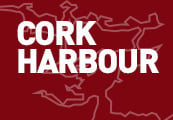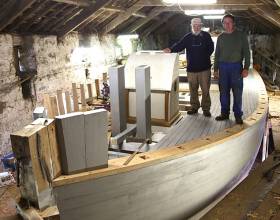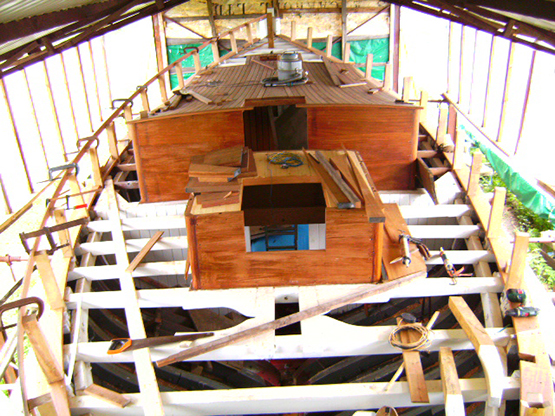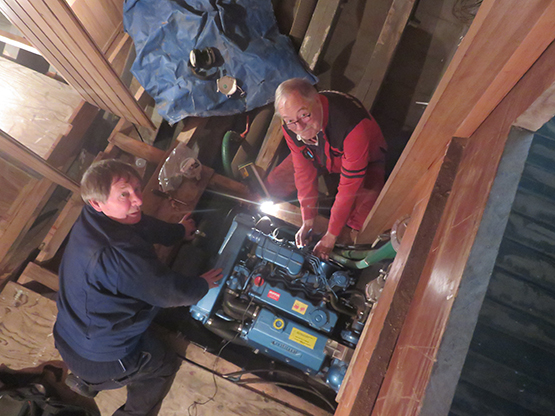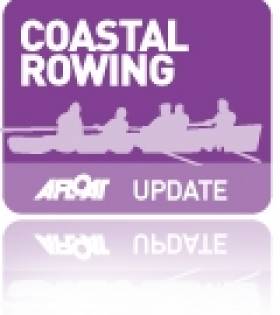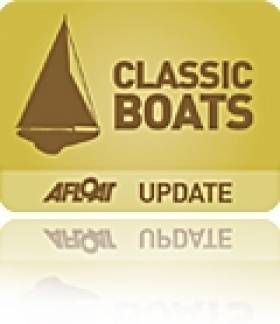Displaying items by tag: Ilen
Conor O’Brien Ketch Ilen’s Deck to Be Completed By Mid-October
The re-decking of the 57ft Conor O’Brien ketch Ilen (originally built Baltimore 1926) is the latest stage of this major restoration/re-build project to be nearing completion at Liam Hegarty’s boatyard at Oldcourt on the Ilen River between Skibbereen and Baltimore writes W M Nixon. It is expected that the deck will be signed off by October 15th, and work will then proceed on more detailed work.
As part of the project, the new bowsprit – built by trainees in the Ilen Boat-building School in Limerick – was delivered down to Oldcourt last Saturday, and Ilen School Director Gary MacMahon reports a magic moment when Baltimore sailing legend Dermot Kennedy, owner himself of a similar ketch the Richard, called by Oldcourt on Saturday to give the deck his blessing and welcome the bowsprit to West Cork.

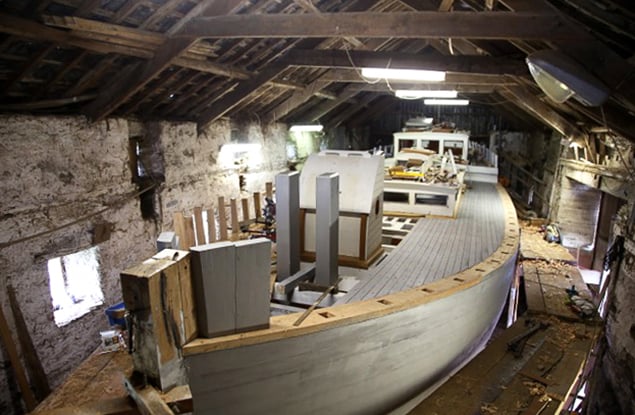 Combined effort. While the hull and deck of the Ilen have been re-constructed in the boatyard at Oldcourt in West Cork, all the deckhouses and hatches have been built in the trainee workshops of the Ilen Boat-Building School in Limerick. Photo: Gary MacMahon
Combined effort. While the hull and deck of the Ilen have been re-constructed in the boatyard at Oldcourt in West Cork, all the deckhouses and hatches have been built in the trainee workshops of the Ilen Boat-Building School in Limerick. Photo: Gary MacMahon
All the deckhouses, hatchways and similar “cabinet” work in the Ilen project has been done in Limerick and then trucked to Oldcourt. There, the main part of the hull and deck re-building has been progressing steadily, sometimes drawing on the talents of international traditional boat-builders who have been enticed to the magnet of West Cork by the quality and scale of the workmanship being produced by Liam Hegarty and his team.
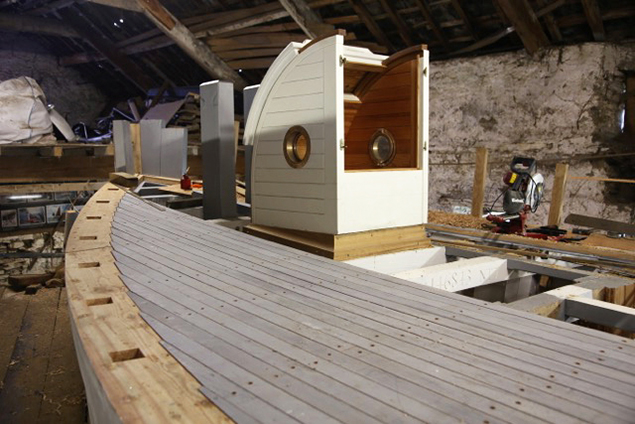 While you wouldn’t expect to find a forehatch like this on a modern offshore racer, on the traditional ketch Ilen the new Limerick-built forehatch housing looks very much at home. Photo: Gary MacMahon
While you wouldn’t expect to find a forehatch like this on a modern offshore racer, on the traditional ketch Ilen the new Limerick-built forehatch housing looks very much at home. Photo: Gary MacMahon
IIen was originally commissioned in 1925 by the Falkland Islanders to be their inter-island communications vessel after they had been properly impressed by her smaller sister, Conor O’Brien’s own-designed 42ft ketch Saoirse, which called to the Falklands in 1925 after rounding Cape Horn during his pioneering global circumnavigation.
O’Brien agreed to be involved with the Ilen project with Tom Moynihan the master shipwright of Baltimore, and then when the vessel was completed, her sailed her out to the Falklands. Because his only qualification was as a yachtmaster, for the delivery voyage the Ilen had to be registered as a yacht for insurance purposes, and she made the voyage under the burgee of the Royal Irish Yacht Club.
 The Ilen on her launching day at Baltimore, 1926. She had to be registered as a yacht for insurance purposes, as her skipper Conor O’Brien’s only qualification was as a yachtsmaster, so he made the delivery to Ilen’s new owners in the Falkland Islands sailing under the burgee of the Royal Irish YC. This also obliged him to carry the RIYC’s then-recognised British blue ensign. But a look at this photo soon reveals the Irish ensign under the bowsprit, celebrating the fact that in making his 1923-25 circumnavigation with Saoirse, Conor O’Brien became the first captain to sail on any major voyage under the Irish tricolour
The Ilen on her launching day at Baltimore, 1926. She had to be registered as a yacht for insurance purposes, as her skipper Conor O’Brien’s only qualification was as a yachtsmaster, so he made the delivery to Ilen’s new owners in the Falkland Islands sailing under the burgee of the Royal Irish YC. This also obliged him to carry the RIYC’s then-recognised British blue ensign. But a look at this photo soon reveals the Irish ensign under the bowsprit, celebrating the fact that in making his 1923-25 circumnavigation with Saoirse, Conor O’Brien became the first captain to sail on any major voyage under the Irish tricolour
Christmas Dreams Of Irish Wooden Boats – Old & New, Real & Fantasy
The season is upon us for goodwill and dreams of very special gifts. And for many Irish sailors, the dream Christmas present would be an elegantly classic or solidly traditional wooden boat, with all maintenance and running costs somehow covered by Divine Providence into infinity……W M Nixon goes down the Yuletide timber trail.
Love of wood is part of what we are. It’s in our genes. At some times and some places in the remote past, an instinctive fondness for wood, and an inherited ability to do something useful with it, would make all the difference between survival and extinction. So though today the availability of other more purposeful materials may have transformed boat-building, a new boat without some sort of wood trim is a very rare thing indeed.
At a more personal level, many of today’s generation of sailors cherish family memories of the communal building of wooden DIY kit boats at home. Here, there and everywhere, a drawing room or little-used dining room found itself a useful new purpose as a boat-building salon, with Mirror dinghies and occasionally larger craft taking shape in domestic settings throughout the land.
“Our daddy the boat-builder” became a household name in his own household. And for those who sometimes wonder why today’s adult sailors can become misty-eyed at the very thought of the Mirror dinghy (which really was and is a wonderful design and concept), the answer surely is that at a significant stage of their sailing and family life, a Mirror dinghy was centre stage, the symbol of a family’s shared values, hopes and interests.
But maybe the most important thing about the Mirror is that she is so eminently practical. So perhaps at Christmas we should allow our imaginations to take flight and soar high to envisage the complete wooden dreamship. And there she is as our header image, introducing this week’s meandering thoughts. That schooner at the moment is total fantasy. But any sailing enthusiast who looks at that concept design and doesn’t think: “Now there’s my dreamship”, well, he or she just doesn’t have a true sailing soul.
The origins of Eirinn, as she is named for the time being, go back to 2012, when the nascent Atlantic Youth Trust sought suggestions as to what a new sail training vessel for all Ireland should look like. But with their proposals recently getting the first real hints of a fair wind from both governments, the AYT have gone firmly down the route of a 40 metre steel barquentine.

The Ilen as she was in the Spring of 2015 in Oldcourt...
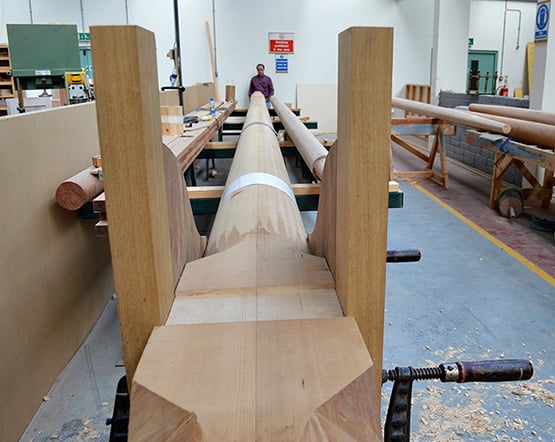 ….while in the Ilen Boatbuilding School in Limerick, spars and deckhouses were taking shape
….while in the Ilen Boatbuilding School in Limerick, spars and deckhouses were taking shape
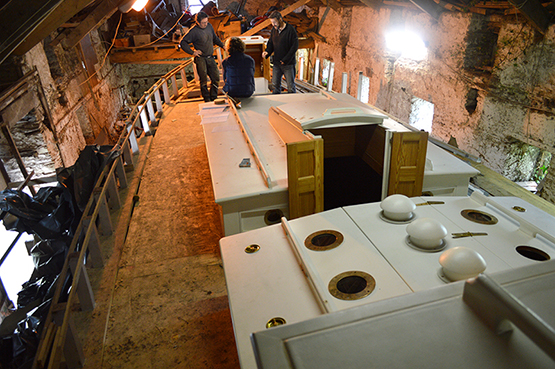
Deckhouses built in Limerick are offered up on the Ilen in Oldcourt
However, down in Limerick where they were busy with moving forward the restoration of the Conor O’Brien 1926 ketch Ilen at two sites – the hull with Liam Hegarty in Oldcourt near Baltimore in West Cork, and the deckhouses, spars and other smaller items being built at the Ilen Boat Building School in Limerick – they gave some thought in 2012 to the possible form of a new sail training vessel. They came up with the concept of a classic 70ft schooner which they knew, thanks to the work on Ilen, that they could build themselves using the skills learned and deployed in re-building the O’Brien ketch.
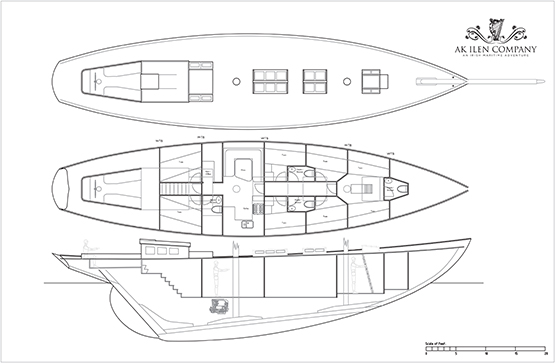
A classic hull for a classic schooner – Theo Rye’s profile and general arrangements plan for the schooner concept of 2012
But with the Ilen project moving steadily on towards the vessel’s commissioning next summer, and with other directly-related new proposals at an advanced stage in the pipeline, that sublime schooner concept is in a sort of limbo, truly a fantasy.
Yet she’s such a lovely thing that we’re happy to use her as our symbol of Christmas cheer. Her creators are Gary MacMahon of the Ilen Boatbuilding School, and Theo Rye, who is best known as a technical consultant in naval architecture, and on clarifying matters of design history and detail in boat and yacht design. But he can turn his hand to all sorts of design commissions if required. He came up with the clever concept for the CityOne dinghies in Limerick, and when Gary started musing about a classic training schooner, within the scope of what the Ilen school could do, as their answer to the AYT sail training vessel query, Theo came up with the goods and then some.
In fact, the design of the hull is so perfect that we’ll run it again right here to save you the trouble of scrolling back to the top. The overhangs at bow and stern are in harmony, but it is the sheerline which is the master-stroke. There isn’t anything you’d want to change in it, yet when you look at other famous schooners such as the fictional Southseaman (in real life she was Northern Light) in Weston Martyr’s masterpiece of maritime literature The Southseaman – the Story of a Schooner (1926), we see a sheerline which is too flat in the way of the foremast. But with Eirinn, the curve is just right, and it’s something achieved by tiny adjustments and balances which the eye can’t really perceive, yet somehow it registers the sublime harmony of the total concept.
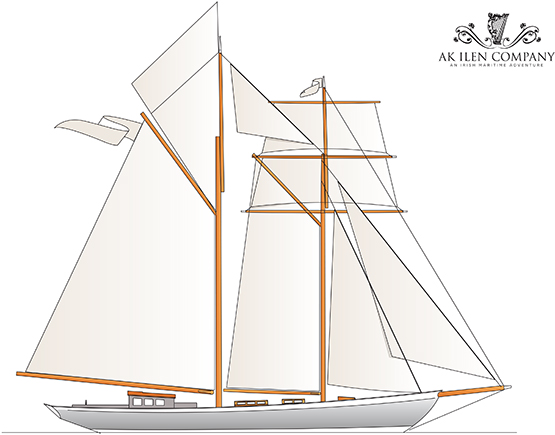
Worth a second look – and then a third one. The longer you look at the lines of Eirinn, the sweeter they seem. But her overall appearance might be improved with a slight rake of the masts
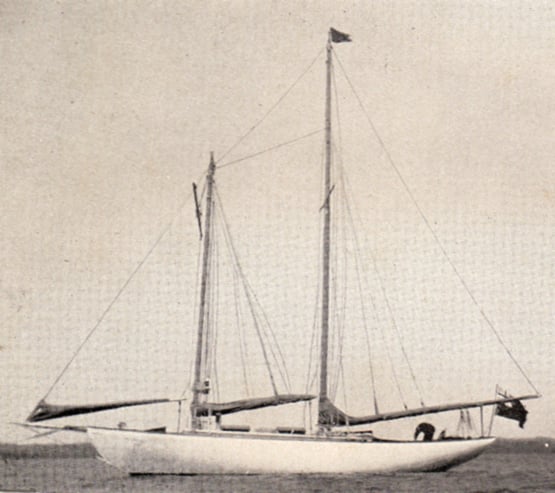 A schooner sheer not quite right – Weston Martyr’s Southseaman (aka Northern Light) could have done with a livelier sheerline abeam of the foremast.
A schooner sheer not quite right – Weston Martyr’s Southseaman (aka Northern Light) could have done with a livelier sheerline abeam of the foremast.
So Theo Rye not only writes critiques of other people’s designs, but if given the chance he can personally come up with something which is wellnigh impossible to fault. Of course, we mightn’t quite go for the same rig – a little bit of rake in the masts wouldn’t go amiss - and for private use you’d want something a little different from the dormitory layout of the training ship. But that said, this is a beautiful yet not excessively pretty-pretty hull, a boat which sings. And the fact that she’s beyond just about every private owner’s reach only adds to the mystique.
But to redress the balance, last week we’d an inspiring evening’s entertainment and information about a dreamship which really is being re-created. It was the December gathering of the Dublin Bay Old Gaffers Association in the ever-hospitable Poolbeg Y & BC, and a full house was there to hear about how Paddy Murphy of Renvyle in the far northwest of Connemara is getting on with his mission of bringing the famous Manx sailing nobby Aigh Vie back to life.
Paddy himself is something special. When asked his trade, he says he’s a blacksmith. But he can turn his hand to anything. Originally a Dub, his early sailing experiences included owning a Flying Fifteen and a Dragon, though not – so far as I know – at the same time. But then got the gaff rig traditional boat bug, and a sail on Mick Hunt’s Manx nobby Vervine Blossom sent him in pursuit of near-sister Aigh Vie. She was reportedly for sale, having for a long time been the pet family cruising boat of Billy Smyth and his family at Whiterock Boatyard on Strangford Lough, after spending her final working years fishing as a motorized vessel out of Ardglass.

Aigh Vie as she was in Whiterock Boatyard when Paddy Murphy bought her, her elegant huul shape clearly in evidence
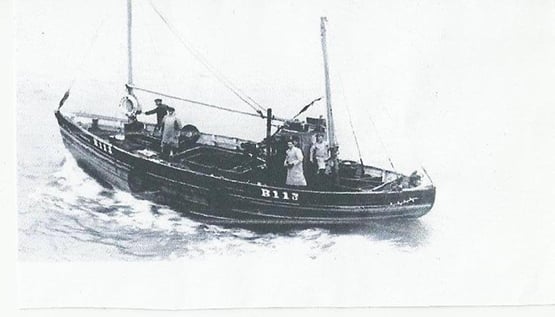 Aigh Vie in her final working days as a motorised fishing boat based at Ardglass
Aigh Vie in her final working days as a motorised fishing boat based at Ardglass
The deal was done, an ideal buy for a special man like Paddy Murphy, for the Aigh Vie is one very special vessel. The Manx fishing nobbies reached their ultimate state of development in the first twenty years of the 20th Century before steam power and then diesel engines took over. The nobby evolved to an almost yacht-like form through vessels like the 43ft White Heather (1904), which is owned and sailed under original-style dipping lug rig by Mike Clark in the Isle of Man, and the 1910 Vervine Blossom, now based in Kinvara, which was restored by Mick Hunt of Howth, but he gave her a more easily-handled gaff ketch rig which looked very well indeed when she sailed in the Vigo to Dublin Tall Ships Race in 1998.
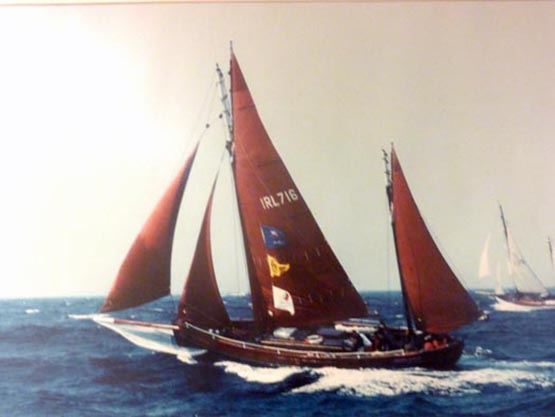
It was a sail on Mick Hunt’s 1910-built Manx nobby Vervine Blossom which inspired Paddy Murphy to go in pursuit of Aigh Vie
It takes quite something to outdo the provenance of these two fine vessels, but the story of Aigh Vie (it means a sort of mix of “good luck” and “fair winds” in Manx) is astonishing. It goes back to the sinking of the Lusitania by a German U Boat off the Cork coast in May 1915, when the first boat to mount a rescue was the Manx fishing ketch Wanderer from Peel, her crew of seven skippered by the 58-year-old William Ball.
They came upon a scene of developing carnage. Yet somehow, the little Wanderer managed to haul aboard and find space for 160 survivors, and provide them with succour and shelter as they made for port. In due course, as the enormity of the incident became clear, the achievement of the Wanderer’s crew was to be recognised with a special medal presentation. And then William Ball, who had been an employee of the Wanderer’s owner, received word that funds had been lodged with a lawyer in Peel on behalf of one of the American survivors he’d rescued. The money was to be used to underwrite the building of his own fishing boat, to be built in Peel to his personal specifications. The name of the donor has never been revealed, but the result was William Ball’s dreamship, the Aigh Vie, launched in December 1916 and first registered for fishing in January 1917.
Over the years, the Aigh Vie became a much-loved feature of the Irish Sea fishing fleet. Tim Magennis, former President of the Dublin Bay Old Gaffers Association, well remembers her from his boyhood days in the fishing port of Ardglass on the County Down coast. Her working days over, Billy Smyth gradually converted her to a Bermudan-rigged cruising ketch with a sheltering wheelhouse which enabled the Smyth family to make some notable cruises whatever the weather. His son Kenny Smyth, who now runs the boatyard with his brothers and is himself an ace helm in the local 29ft River Class, recalls that the seafaring Smyth family thought nothing of taking the Aigh Vie to the Orkneys at a time when the average Strangford Lough cruiser thought Tobermory the limit of reasonable ambitions.
After he’d bought the Aigh Vie and brought to her first base in Howth, Paddy Murphy soon realised he’d still a lot to learn about sailing and about keeping hard-worked old wooden boats in seafaring condition. But he’s such an entertaining and inspirational speaker that you’re swept along in his enthusiasm and empathise with his admission that, now and again, he felt things were getting on top of him.
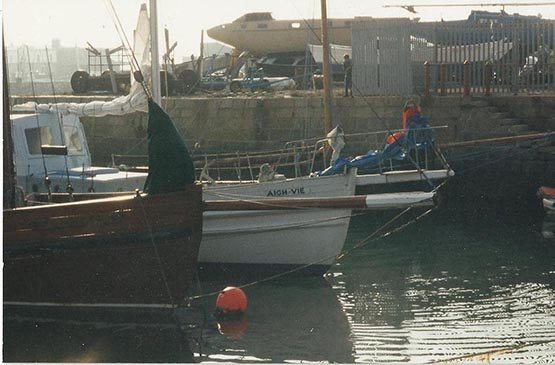
Sisters - Vervine Blossom (foreground) and Aigh Vie in Howth
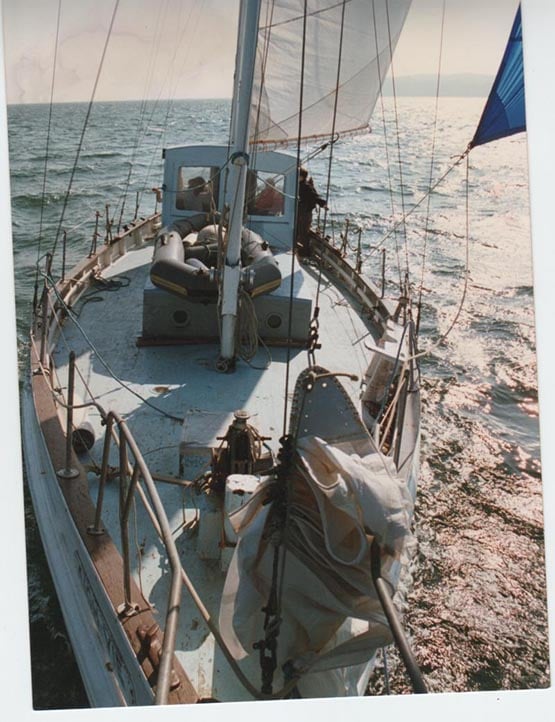
Sailing days on the Aigh Vie from Howth, before it was decided that she needed a major restoration
Following several seasons with increasing evidence of problems, he decided that a virtual re-build was necessary. It was then that the Dublin wooden boat owners’ perennial problem shot to the top of the agenda. In our very expensive city, the space and shelter to work long hours at an old wooden boats is almost impossible to come by, and he’d to shift the big Aigh Vie several times. On one occasion, he was asked to move in a hurry out of an ESB shed, but was offered £1,000 (this was pre-Euro days) to do so. He moved heaven and earth and finally found somewhere else at considerable expense, got the Aigh Vie installed there, and then went back to collect his thousand snots. Only to be laughed at. The manager told him it was the only way he could see to get the old boat moved out, but there were absolutely no funds available at all for such a thing, and surely Paddy would have guessed that?
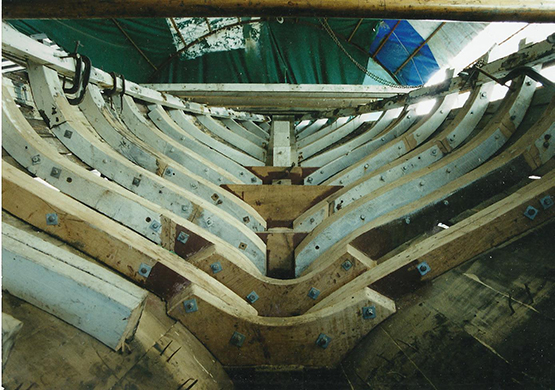
The re-building under way at Renvyle, using the technique where hull shape is retained by first replacing every other frame
With one thing and another, he moved to Renvyle in Connemara where he liked the big country and the open spaces and the friendly people right on the edge of the Atlantic, and in time Aigh Vie came too, and found herself being slowly re-born under a special roof. But it was demanding work for one man, so every so often a team led by Paul Keogh of the famous Galway Hooker from Clondalkin, the Naomh Cronan, together with a good selection of DBOGA specialist talent, descends on Renvyle to put in a ferocious day or two of work, and then on the Saturday night they put a fair bit of business the way of the pub at Tullycross.
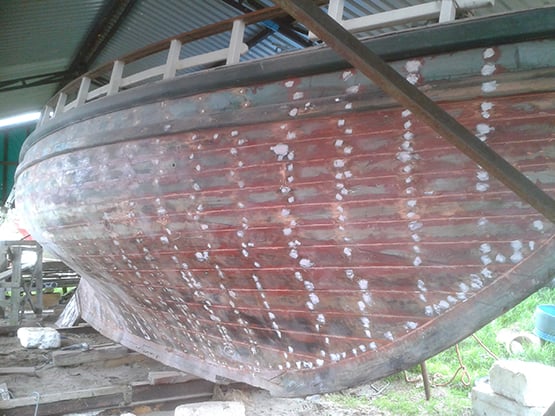
The planking was more easily restored by laying the Aigh Vie over on her side
Agh Vie upright again, and the deckhouses are being put in place
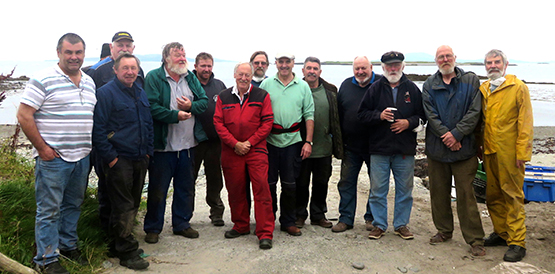
Old Gaffers Association International President Sean Walsh (right) and Peter Redmond install Aigh Vie’s new Perkins diesel. Photo: Cormac Lowth

One of the options for Aig Vie’s rig is the classic lug ketch as shown here with Mike Clark’s 1903-built White Heather
So now, many years later, the journey towards the restored Aigh Vie is getting near its destination. But it will never be fully ended. Thanks to sails, spars and rigs donated from other boats, Paddy has the choice of either gaff ketch or classic lug rig, so she’ll always be work in progress. Which is good news. Because every couple of years or so, the DBOGA can guarantee a full house to hear Paddy Murphy talking about how the Aigh Vie story is going.
He’s a wonderful speaker, sometimes almost messianic, and he shares his every feeling. Thus he mentioned that one day he was feeling a bit low, and he just went out to look at the big boat down by the shore, seeking some sort of inspiration. His mind had been elsewhere with the details of completing the interior, but he suddenly realised that he was at the stage of thinking of putting the white paint on the topsides. So he just set to with a big paint brush and a bigger tin of paint, and Aigh Vie was transformed. So was he. “That’s the secret” says he. “If you’re feeling a bit down, just go out and slap on some white paint. It works wonders.”

Feeling a bit down? Then just go out and slap a coat of white paint on the boat – it works wonders
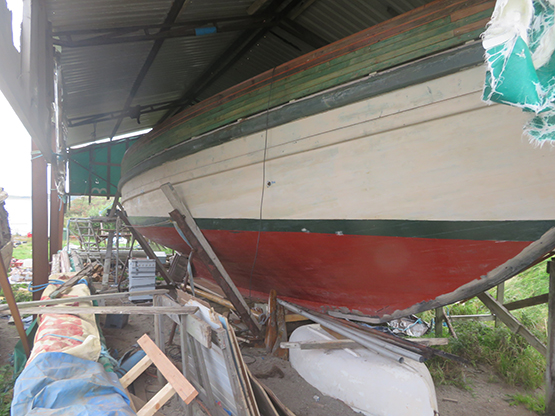
New Traditional Rig for the Good Ship Ilen
An international gathering at the Ilen School, Roxboro, Limerick of expert marine traditional riggers, sailmakers and classic boatbuilders, might induce one to speculate that a sailing ship is somewhere in Ireland nearing completion. And yes, this gathering of last Friday, clearly marks a significant juncture in the rebuild of Ireland’s 1926 wooden sailing ship Ilen. The way has now been mapped, essential tasks identified, and if rebuilding milestones are achieving, then there is no reason to think that the good ship will not be plying a new trade in Education of the Sea by late summer 2016.
Limerick Boatmen Row 180–Miles in Angling Cot
#anglingcot – The Ilen School, Roxboro, are today celebrating a great River Shannon adventure. This adventure involved 180–miles of rowing from Belleek in Fermanagh to Limerick City, over a two week period, by a team of two Ilen School boatmen - Tony Daly and Liam O'Donoghue, both residents of Ballynanty.
Not only did this intrepid duo navigate their traditional 23ft–wooden City Angling Cot to Limerick, through ever-changing river terrain, great lakes and canals, but they also built the beautiful craft using traditional skills over the winter months at the Ilen School.
This adventure further exemplifies the life-long learning philosophy of the Ilen School, which valorises the direct experience of individuals above all else. The school is planning many such adventures in the years ahead, and welcomes the "youth of all ages" with a sense of adventure for building in wood, community building and voyaging on rivers and sea to get involved.
#baltimorewoodenboatfestival – The Ilen School Gandelow crew are celebrating back in Limerick after taking the big rowing prizes at the Baltimore Wooden Boat Festival last weekend.
Rowing races at the West Cork festival included on Sunday a Pilot Race Event under sail and oar; a race to land a pilot on an incoming sailing boat in the Harbour then race back to finish at the Pier.
The crew were: Br Anthony Keane, Gary Wilmott, Matt Dirr, Ger Ryan, Tony Daly, Robert Smalle, Liam O'Donoghue, Mike Grimes and James Madigan.
More on the wooden boat festival
#woodenboats – In the annals of Irish seafaring, whether professional or amateur, only a very few can match the achievement of Conor O'Brien (1880-1952). Between 1923 and 1925, this multi-talented sailor from Foynes on the Shannon Estuary circled the world south of the Great Capes in the 42ft ketch Saoirse which he'd designed himself with the help of Tom Moynihan of the Baltimore Fisheries School Boatyard.
It was there that this unique vessel was built in 1922-23 as Ireland in general – and West Cork in particular – recovered from a short but brutal Civil War. The very fact that Saoirse was built in Baltimore, followed by the successful completion of her great voyage, became part of the slow post-war healing process. So as the 2015 Traditional and Classic Boat Season gets under way this weekend with the Baltimore Wooden Boat Festival, W M Nixon voices the hope that Saoirse – which had been feared totally lost since 1979 – may be re-born.
They're hardy sailors in West Cork. That lotus-land of easygoing cruising may seem a gentle place in high summer, yet down there they've felt the recent summer-delaying cold spell as sharply as anywhere else. But despite the unfavourable conditions, as usual in this last full weekend of May we'll see the Baltimore Woodenboat & Seafood Festival swing into action. And although wooden boats need reasonably good springtime weather almost as an essential for the annual refit, there'll be a colourful turnout of character vessels large and small.
But the talk of the town will not be about a boat which is showing her style off the busy Baltimore waterfront today. Indeed, not only will this very special boat not be there, but it's a moot point as to whether she still exists. Put another way: Does enough of Saoirse still exists to allow a re-creation of this wonderful little ship to be properly classified as a re-build?
The voyage of the Saoirse in 1923-1925 only gains further lustre and wonder with the passage of time. It was an achievement of greatness, yet of beautiful simplicity. It was a uniquely pioneering venture made by an Irish skipper in an Irish designed-and-built vessel, and it was the first major voyage by an Irish ship of any size flying the Tricolour ensign of the new-born nation.
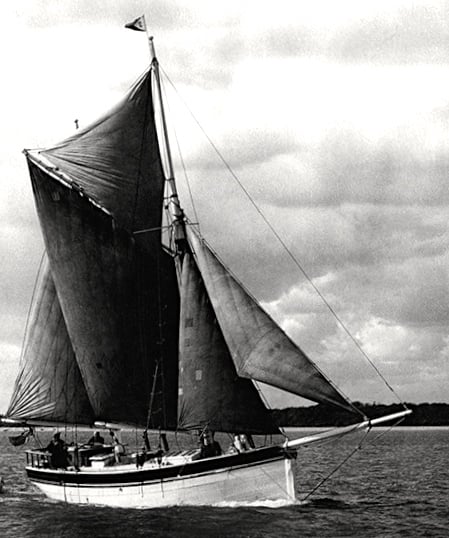
Saoirse under her original ketch rig in the 1950s, but with a boom fitted to the mainsail. Conor O'Brien had a loose-footed mainsail, and as evidenced here, the sail would have set much better but would have needed more attention in handling. (From a photo by Eric Hiscock)

In dry dock during the 1950s, Saoirse's "cod's head & mackerel tail" hull shape is clearly seen. Yet in the Great Southern Ocean on her voyage round the world south of the Great Capes, this bluff little 42ft ketch regularly logged 180 miles a day in comfort.
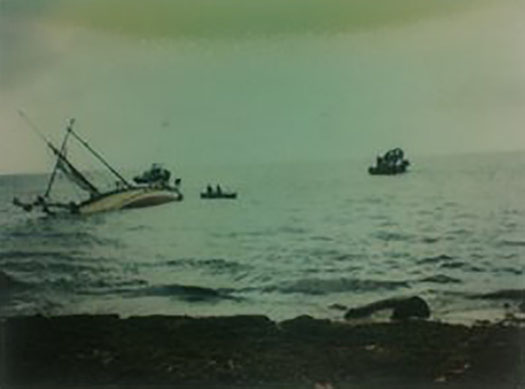
The wreck of the Saoirse in Jamaica, 1979.
Thus when the news in 1979 of Saoirse's destruction in a hurricane in Jamaica was confirmed, if anything it added to the legend. But it also meant that the only other boat created by the same team in the same place – the 56ft trading ketch Ilen (1926) – acquired added significance. But she was a long way away, still working the stormy seas around the Falkland Island, for which she'd been built after the islanders had been so impressed by the capabilities of the Saoirse, when she called there after rounding Cape Horn from the west, that they ordered a bigger sister-ship to become the inter-island workboat .
Yet thanks to a totally single-minded approach by Gary MacMahon of Limerick, Ilen was brought back to Ireland in 1998. And though it has taken quite a while for the various ideas to become reality, she is now well on the way to what has become a very public restoration with Liam Hegarty at Oldcourt Boatyard near Baltimore, while the Ilen Boatbuilding School in Limerick has become part of the fabric of Shannonside life, building not only the deckhouses and spars for Ilen herself, but an interesting selection of smaller boats ranging from traditional Shannon gandelows to the new CityOne sailing dinghies.

A man who just doesn't give up. Gary MacMahon of the Ilen School in Limerick. Photo: W M Nixon
By any standards, all these projects would be remarkable achievements in themselves. But in addition to his day job running one of Limerick's leading design studios, Gary MacMahon has for twenty years and more been quietly accumulating every bit of documentation of all sorts there is to be found relating to Saoirse.
It's an absolute treasure hoard of old photographs, certificates, plans, artefacts and other materials. And through this collecting, he has become well acquainted with Anthony Bolton who was Saoirse's last owner. Bolton had the misfortune of seeing his beloved boat destroyed by a hurricane in Jamaica before rescue attempts could save her after she'd dragged her anchor and gone ashore.
But though Saoirse was broken up by the battering of the hurricane, substantial pieces of her remained on the sea bed, and two sea-worn iron hanging knees – lovingly fitted by the Baltimore shipwrights 93 years ago – have recently been confirmed as definite relics of the wonderful little ship.
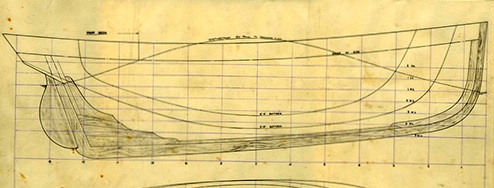
The hull lines of Saoirse as taken off by Uffa Fox in Cowes in 1927 before the start of that year's Fastnet Race (from which she retired, as endless windward work was not what she was designed for). Thanks to documentation of this quality, it will be possible to re-build Saoirse with precision. But in fact it has emerged that, such was the skill of Tom Moynihan and his boatbuilders in Baltimore in 1922-23, Saoirse as built very accurately followed the original lines drawn by O'Brien and Moynihan.

Saoirse's hull sections as recorded by Uffa Fox in 1927.
More importantly, though, the word is that much of the keel may still be intact. So just as he somehow got himself to the Falkland Islands to buy Ilen back in 1997, Gary MacMahon will shortly be going on the much easier journey to Jamaica for some real on-the-spot research as to just how much of Saoirse survives.
These days, it need only be a very small piece of the original to count as a re-build. But the spirit of the Ilen School is such that even if they find nothing at all in Jamaica, the notion of re-creating Saoirse is gaining so much traction, with that great shipwright Liam Hegarty among those totally taken with the idea of seeing Conor O'Brien's characterful little masterpiece sail again, that already the idea has acquired its own momentum.
But there'll be time enough when winter comes around again to give proper attention to the full range of Saoirse material which Gary MacMahon has amassed in order to ensure an authentic re-build. Meanwhile, this weekend may be seeing the new classic and traditional boat season kick into action in Baltimore, but already things are well under way in France, with last week's huge gathering in the Morbihan on the Biscay Coast, to which seven Dublin Bay Waterwags travelled, and eight returned.
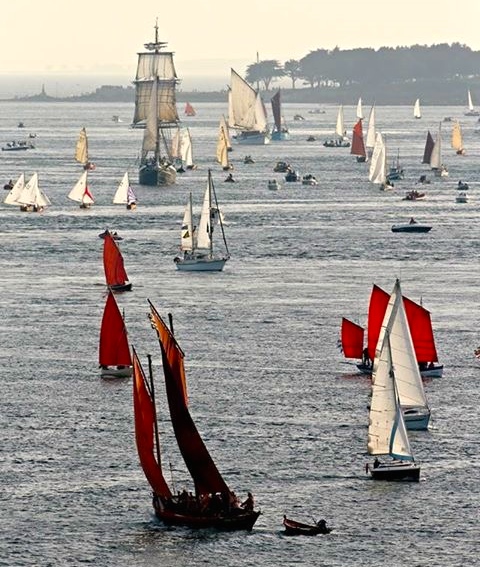
The wonders of the Morbihan. A very small part of the fleet at the Sailing Week eight days ago, with four of the Dublin Bay Water Wags at mid left. Photo: Courtesy Judith Malcolm
Like all the great French classic and tradboat festivals, the Morbihan event (it's full title is La Semaine de la Voile du Golfe de Morbihan, that's Morbihan Sailing Week in simple English) was mind-bending in terms of numbers, with 1200 boats of all shapes and sizes taking part. But the scale and layout of the Morbihan is such that it could well cope. The extensive inlet has six main ports, so the fleet was divided into six sub-groups of around 200 boats each. Everyone mingled out on the water during the day, then each night of the week-long festival saw your group going to a new port.
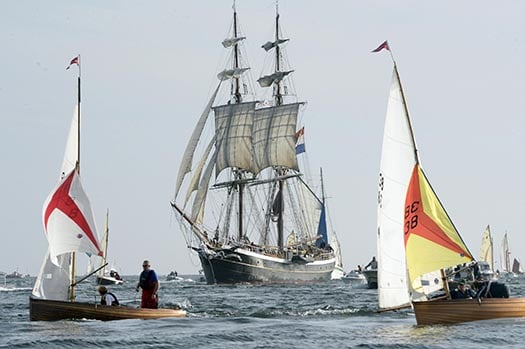
Two little Water Wags a long way from home – Ian & Judith Malcolm in the hundred year old Barbara (left) and Guy and Jackie Kilroy in Swift (right) in the midst of "sundry boats" in the Morbihan eight days ago. Photo courtesy Judith Malcolm
It worked, and it worked so well that the Irish flotilla of one Shannon One Design (Reggie Goodbody) and seven Water Wags not only had themselves a fine old time, but in a reversal of the usual story where our people return from distant places short of a boat or two, they came back with eight Wags, as Adam Winkelmann was united with his new boat. It was built in France as a boat-building academy exercise with a finish so exquisite that it was on exhibition in a marquee, but he was allowed to bring it home with him to Dublin Bay.
Far to the southwest in Baltimore, today we'll see a complex programme, as several traditional rowing craft (including a 23ft traditional Shannon cot or brochaun, the latest creation of Limerick's Ilen School built by a team headed by Tony Daly) were due to launch last night to berth at the pontoon in Skibbereen beside the West Cork Hotel. Today at 11am they start a rowing race all the way down the Ilen to Baltimore. Fortunately, the tide is ebbing.....
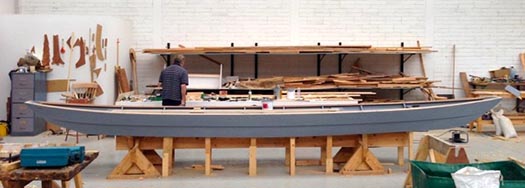
The new 23ft Shannon cot or brochaun is the latest creation of the Ilen School in Limerick. The cot's usual task was to head upriver from Limerick to fish, but today this boat will be rowed down the River Ilen from Sibbereen to the Baltimore Woodenboat Festival.
The rest of the day will see sailing and rowing races off Baltimore with a prize-giving dinner tonight in Baltimore Sailing Club presided over by Tom MacSweeney of this parish, then tomorrow (Sunday), as the one day Seafood Festival gets into full swing, there's perhaps the most interesting event of all afloat. This is the Pilot Race, in which the sailing boats put out to sea, and then turn and approach the harbour to be met by racing gigs each of which has to put a pilot on board one of the sailing craft which then race back into the harbour – it all makes for mighty sport.

Bowsprits at the ready, and the island ferry coming into port – it can only be Baltimore at Woodenboat Festival time
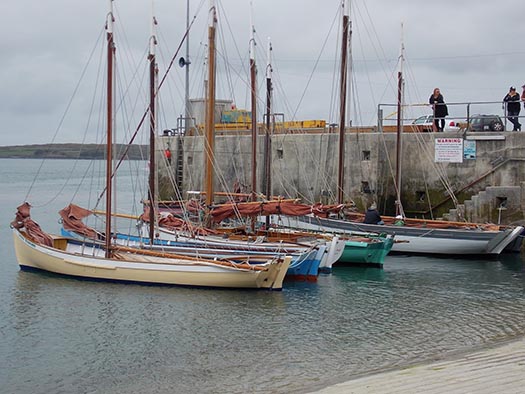
If you can identify even half of the boat types here, then you should be in Baltimore this weekend.
If your heart is with classic and traditional sailing boats, you can get an abundance of them by being in Baltimore this weekend, and then by being along Dublin's Liffey for the Riverfest in a week's time for the Bank Holiday weekend. It's a three day event (May 30th to June 1st) based on Poolbeg Y & BC, with the Old Gaffer's Leinster Trophy Race in Dublin Bay on Saturday, and then two days above the bridge for all sorts of city festivities and boat parades through to Monday evening.

The 117-year-old Howth 17s will be returning to the Dublin Riverfest in a week's time. Photo: W M Nixon
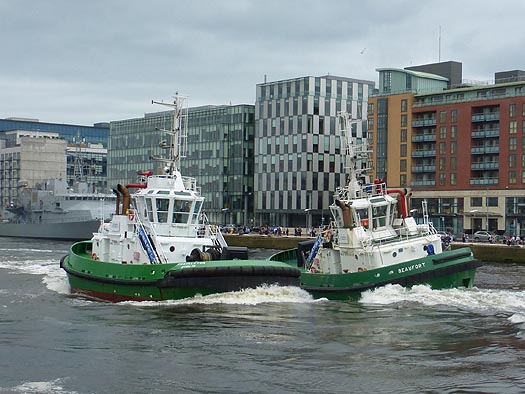
The famous waterborne ballet of the Dublin Port tugs Shackleton and Beaufort will be a main event in the Dublin Riverfest over the Bank Holiday Weekend of May 31st-June1st. Photo: W M Nixon
Following that, on Saturday 6th June out in Howth, the Classic Lambay Race is being provided within the annual Round Lambay Regatta (it dates back to 1904), with the Old Gaffers and Traditional boats joining the 117-year-old Howth Seventeens for a direct circuit from a pier start out to Lambay, round it and back again direct, with no fancy special mark rounding in between.
Defending champion in the Classic Lambay is OGA International President Sean Walsh of Dun Laoghaire with his cutter Tir na nOg, and extra interest is added this year as the fleet will include Dickie Gomes' 1912-vintage 36ft yawl Ainmara, built in Ringsend but now a longtime resident of Strangford Lough. There's a certain edge to Ainmara's involvement, as she was overall winner of the cruiser division in the 1921 Lambay Race when still owned and sailed by her designer-builder John B Kearney. But if you think this remarkable historic link will cause her opponents to give her an easy time of it, you're much mistaken.
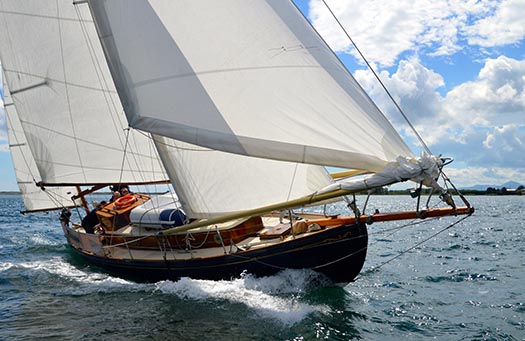
The 103-year old Ainmara – seen here on her home waters of Strangford Lough with the Mourne Mountains in the distance – will be returning to the Lambay Classic at Howth on June 6th 2015, which she last won in 1921. Photo: Pete Adams
Sean Walsh is having a busy year of it, as his duties as OGA President take him hither and yon, while Tir na nOg will be flagship for the OGA Cruise-in-Company which will follow the big one of 2015, the Glandore Classics Regatta from July 18th to 24th.
But for this weekend, he's in his home waters of Dublin Bay on a venture which means a lot to him, the OGA Youth Sailing Project at Poolbeg under the direction of Liam Begley. It's for youngsters who might not otherwise get a chance to sail. They're taken out to learn the ropes aboard two fine gaff cutters, the Clondalkin Community group's majestic Galway Bay hooker Naomh Cronan, and the OGA President's own Tir na nOg.
When we remember that many folk head from Dublin towards Cork to go sailing, it's intriguing that in this case the young people have come the other way, as they're a group from Mayfield Community School which has eternal fame through being the old school of Roy Keane.
The tyro sailors from Mayfield – there's nine of them, all in the 15-16 age group - have already become boat-acquainted through the Meitheal Mara Community Boatyard in Cork city. But the outing to Dublin puts a different spin on it all, as the first stage is devoted literally to teaching them the ropes, then after the sailing programme is completed out in the bay, the shift in skills is demonstrated by command of the two gaff cutters being given over to the Mayfield crews, who then have to sail them back to port.

OGA President Sean Walsh (top right) with Junior Gaffers from Mayfield Community School in Cork aboard Tir na nOg in Poolbeg in Dublin. Photo: John Galloway
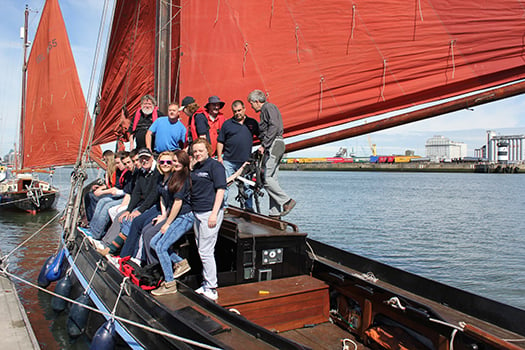
Junior Gaffers from Cork and Senior Gaffers from Dublin aboard the Naomh Cronan Photo: John Galloway
In all, it's an entertaining balance between an outing to Dublin, a chance to learn in a fun environment, and a real opportunity to demonstrate that practical skills have been well and truly acquired. And before somebody is driven to send in a rude comment after seeing these two photos of last year's Youth Sailing Project course, I hasten to assure you that when they do go sailing, everyone wears a lifejacket.
Marine Minister Forecasts Wooden Boat Building Revival
#woodenboat – Marine Minister Simon Coveney is confident that wooden boat building in Ireland is going to be revived writes Tom MacSweeney.
Traditional skills have been lost and there are fears that they will disappear forever, but the Minister sounds a confident note about preserving them on the current edition of my maritime programme, THIS ISLAND NATION.
"This project is going to reinvigorate wooden boat building in Ireland again. It is going to open a new chapter for us," he says. "Hopefully multiple ports around the country will be able to build projects like this in the future. We still have great skill sets of wooden boat building available to us in Ireland which we must not lose. It is projects like this that will keep them alive and encourage a new young generation."
I recorded Mr.Coveney at Liam Hegarty's boatyard at Oldcourt near Skibbereen where the Ilen, the last traditional sailing boat of its kind, is being restored. It is the boat which the legendary Conor O'Brien had built for the Falkland Islanders who so admired his previous vessel, Saoirse, when he sailed it into those islands during his round-the-world voyage in 1923-25. Liam Hegarty's yard at Oldcourt on a bend of the road from Skibbereen to Baltimore in West Cork is one of the few remaining that specialises in wooden boat building.
The Falklanders asked O'Brien, the first Irishman to sail a round-the-world voyage to emulate the boat on which he arrived in Port Stanley. He did as they asked, having the Ilen built in Baltimore, where Saoirse was also constructed. With two Cape Clear Islanders as crew, he sailed it to the Falklands in 1926 where it worked for 70 years until Limerickman, Gary McMahon, had it brought back to Ireland in 1997:
I was the only reporter on the quayside in Dublin when it was landed there from the deck of a cargo ship, looking every bit her age of 71 years at the time. So it was a great feeling to stand on her deck in Liam Hegarty's boatshed where the restoration work has been carried out, in conjunction with the AK Ilen boat building school, initiated by Gary McMahon, the driving force of the project Such a change from the condition in which I had seen her in the Dublin docks 18 years ago.
Gary McMahon, Liam Hegarty and Minister Coveney tell the story on the programme. Gary and Liam are both confident that Ilen will be back in the water, sailing once again. She may provide opportunities for effective sail training. Several sources have provided restoration funding. More is needed for a project which, as the Minister said, can restore Ireland's resource of traditional skills.
Also on the programme you can hear the story of a submarine which sank not once, but twice, which will make you wonder whether superstition about changing the names of boats is correct. And did you know that the Dubs beat the Kingdom ... Not in football, but fishing...?
You can hear more by listening to THIS ISLAND NATION above.
#tallship – With St Patrick's Day almost upon us, the westward trek across the Atlantic in search of American benevolence and funding for worthy objectives can become a very crowded pilgrimage. Among those looking for meaningful support for their pet projects, there will likely be proponents of some sort of new Tall Ship to replace the much-mourned brigantine Asgard II, and the ketch Lord Rank, both of which foundered in 2008 to leave Ireland - north and south alike - bereft of national sail training vessels.
Since then, there have been re-groupings of those who support the admirable concept of sail training for young people. In all, there may be as many as five different bodies on the island of Ireland which now provide access to the international programme. Coiste an Asgard itself was wound up in 2011, but it was immediately re-born as the Dublin-headquartered Sail Training Ireland, the national authority which carries the imprimatur of Sail Training International, the global body which co-ordinates and regulates all sail training.
The other main organisation, often functioning in tandem with Sail Training Ireland, is the Atlantic Youth Trust. It has offices in both Dun Laoghaire and Belfast, and has as its primary objective the construction and commissioning – for all Ireland – of a Class A 40-metre three-masted barquentine. WM Nixon continues with the story.
When we carried a history and analysis of Ireland's involvement with the International Tall Ship and Sail Training movement on this site on January 17th, the immediate response was formidable, and in favour. It continues to register hits at a rate which shows that the maritime community in Ireland has a real wish to see our own proper tall ship.
To achieve this ambition, in terms of having a clearly outlined plan the Atlantic Youth Trust is way ahead. With leading personnel from many parts of Ireland on its high-powered board of Trustees and Directors, the concept - originally inspired by Enda O'Coineen and John Killeen of Galway – is already becoming very complete.
Executive Director Neil O'Hagan and other have researched globally in order to analyse the success of more than two dozen national sail training schemes, and they have concluded that the best model to learn from is the Spirit of Adventure Trust in New Zealand, which functions through training based around the barquentine Spirit of New Zealand, which at 45.2 metres in "sparred length" is steel built registering at 184 gross tons, and carries 40 trainees.
The funding concept on the capital outlay for building the new ship for Ireland will ultimately rely on a total of €15 million being put up jointly by the two governments in the interests of inter-community and cross-border co-operation. Although the current turmoil in the Northern Ireland political administration might temporarily impair the onward progress of the plan, it seems to have a certain inevitable momentum, and highly-regarded Netherlands-based Dykstra Naval Architects have been retained on the project, as have their associates at Damen Shipyards, who may supply the vessel in flatpack form for final construction in Ireland.
As to running costs, the AYT point out that it will come out of current spending, as the vessel by nature of its work will be able to tap into government funds for social welfare and other youth schemes.
Faced with such a juggernaut of ideas, energy, contacts at top government level, and sheer enthusiasm, it seems churlish to question the validity of what is, after all is said and done, a magnificent project. But there are many in Irish sailing in general and sail training in particular who are concerned about the thinking on which it is all based.
To begin with, while we all admire the maritime spirit of New Zealand, does it make sense to draw conclusions for Ireland from a successful scheme in what is essentially a very isolated island nation? Ireland may be an island nation, but it's clearly wide of the mark to describe us as isolated, and this is reflected in the pattern of tall ships visit. If just six tall ships turn up at one port in New Zealand, it's regarded as a major event. But if less than sixty tall ships turn up at this year's Tall Ships Festival in Belfast at the beginning of July, then it will be regarded as a non-event.
In other words, Spirit of New Zealand usually functions in relative isolation, so it is not sail training as we know it in Europe. In fact, she is more of a floating school cum boot camp which happens to set sails, and in order to keep her very numerous trainee complement of 40 busy, while cruising in New Zealand waters (which she does nearly all the time), she is escorted by a large rib which frequently conveys the trainees ashore for land-bound ventures which sometimes out-balance their sea time.
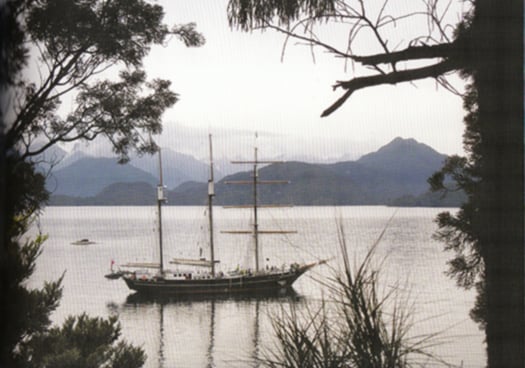
Alone, all alone.....the Spirit of New Zealand in a remote inlet on New Zealand's South Island. With forty trainees and a relatively easily-handled rig, she has a programme whch includes much shoreside activity. Photo courtesy STI
It's a very attractive programme in the New Zealand context, as they have many remote coastal areas which are virtually uninhabited and ripe for shore adventures which will not conflict with the rights of local inhabitants. But in Ireland and much of Europe such a programme would immediately meet problems, and for Ireland it makes more sense to follow the European pattern which puts an almost total emphasis on voyaging and sail training races.
Were a heavily-crewed vessel such as Spirit of New Zealand to do the European programme, there simply wouldn't be enough work for the 20 trainees on each watch to keep them happily occupied for long periods. Ideally, trainee tall ships are extremely labour-intensive for all hands, and in Europe that's the way it is done, but it needs what amounts to individual attention for each trainee.
So it's difficult to escape the conclusion that one reason for the attraction of the New Zealand scheme for the Atlantic Youth Trust is that it wins out in the numbers game. Forty young people taken out of troubled and aimless environments ashore, and sent away together on a voyage, is an impressive amount of social problems temporarily sorted in one fell swoop.
But will it be as behaviourally beneficial, in the long term, as it would be for a smaller number of people on a smaller and busier vessel? It will vary from case to case, but generally you'd reckon that the smaller more personal crew setup, with each trainee more directly involved in the sailing of the ship, would produce better results, while always remember that having as much square rig as possible is central to the concept.
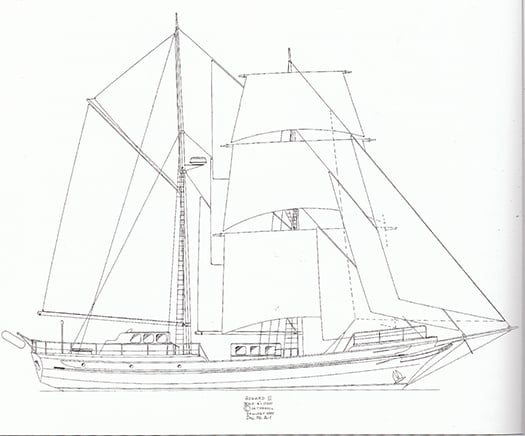
A timeless design which remains a very viable proposition for an easily managed ship which keeps her crew busy. Jack Tyrell's lines for Asgard II would lend themselves to construction in steel or even aluminium.
Ideally, to see Ireland's Tall Ship-owning reputation restored, many of us would like to see not just one newly-built replica of the 84ft brigantine Asgard II being launched, but three – one each for Cork, Dublin and Belfast. For, at the moment, the main axis of Atlantic Youth Trust activity seems to be between Dublin and Belfast. Yet as last weekend's National Annual Sailing Awards ceremony in Dublin so clearly underlined, Cork is really where it's at in terms of maritime development, and the lack of a significant Cork element seems to be a weakness of the AYT scheme.
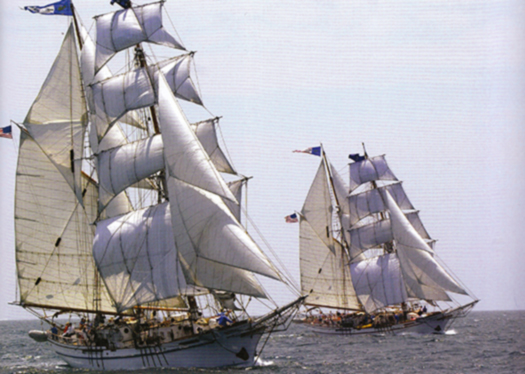
Might this be the way forward? One of our suggestions today is that Ireland really needs three Asgard IIs, based in Cork, Dublin and Belfast. We get an idea of how it might look with the two sister-ship American brigantines Exy Johnson and Irving Johnson, which are based in Los Angeles in California, where they were built in 2002.
Nevertheless, it says much for the dedication and energy of those promoting the Atlantic Youth Trust that we have the luxury of debating the validity of their plans, which have been so thoroughly developed. We may disagree with their conclusion, but it's not total disagreement – an Irish version of Spirit of New Zealand would be a very emphatic improvement on our present ship-less state, which is too much of a reflection of an ancient and negative mind-set.
Every time you see the Tall Ships gather and see how maritime countries of population comparable to Ireland, such as Norway, Denmark and Portugal, can send forth spectacularly handsome Tall Ships, it becomes a painful reminder of how the new Irish Free State increasingly turned its back on the sea.
The fact was admitted by Minister for the Marine Simon Coveney at last week's National Sailing Awards Ceremony in a speech which hinted at some very significant developments in the Irish maritime sphere in the near future.
But really, what Minister Coveney was talking about is that it is time and more for us to grow up in our attitude to the sea. When the Free State was struggling into being in 1922, the popular view was that British power was synonymous with sea power. So if you were against the sea and seafaring in all its manifestations, then you were demonstrating the purity of your patriotism through adopting what was essentially if subconsciously an anti-British stance. Childish perhaps. But we all know that's the way it was.
So despite the flurry of maritime enthusiasm which was engendered by national emergency during World War II to inspire the creation of Irish Shipping and the Maritime Inscription, what this meant was that when the underlying attitude genuinely began to change in the 1950s, a positive attitude towards the sea wasn't being built upwards from Ground Zero. It was being built from Ground Minus Thirty – the number of years that an anti-maritime attitude had been the unstated yet very real official policy.
Thus there was a period when Irish maritime enthusiasm had to be kept going almost as a secret cult, and I'd an odd reminder of this some weeks back at the annual Awards Ceremony of Sail Training Ireland. The Patron of STI is President Higgins, and the event was held – for the second year running – in the Mansion House in Dublin. Yet the very fact of the identity of their Patron, and of their event being staged in the Mansion House in the presence of Lord Mayor Christy Burke, provided such pleasure and pride for everyone in the gathering that it was a forceful reminder that, not so very long ago, seafaring was very much the poor relation in Ireland, and there were those in authority who would have happily air-brushed it out of the national picture entirely, leaving it to foreign crews to undertake the rough trades of the sea.
But thanks to those former members of Coiste an Asgard who refused to give up the vision of sail training for Ireland, even as the onset of economic Armageddon from 2008 to 2011 made any prospect of a new Asgard II a very distant vision as the government chucked the €3.8 million insurance payout into the bottomless pit of national debut, Sail Training Ireland arose like a Phoenix and set in place sail training bursaries for places on foreign tall ships, using international contacts built up during the 27 successful Asgard II years to ensure that Ireland could re-build our position at the heart of the movement.
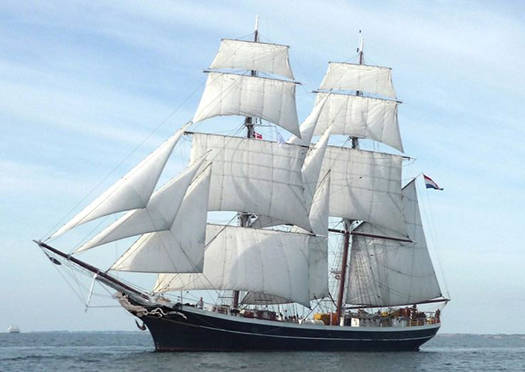
She keeps them busy....the Dutch brig Morgenster is superbly labour-intensive in the best sail training traditions. Photo courtesy STI
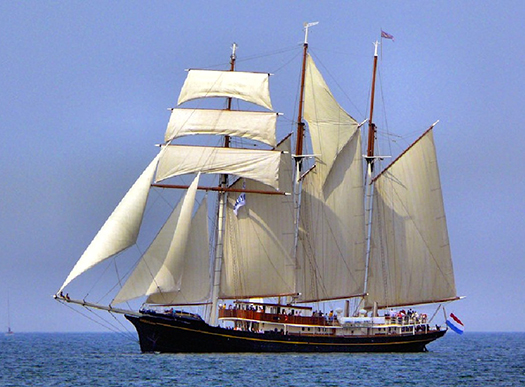
Gulden Leeuw is another of the Dutch Tall Ships which have been taking Irish trainees to sea on Sail Training International programmes. Photo: Courtesy STI
The thriving tall ships scene in the Netherlands – which has become a focal point for sail training and the Tall Ships industry for all Europe – proved the most fruitful placement area, with most Irish trainees being positioned aboard the very handsome 48 m (sparred length) brig Morgenster, which has become a familiar sight in Irish ports. Another ship well used is the three-masted topsail schooner Gulden Leeuw, a long slim craft as she is 70 m in sparred length, while that noted poster girl of Tall Ships sailing, the 56 metre three masted Dutch barque Europa, also carried Irish crew from time to time.
However, while placements on such vessels work very well, the hankering for an Irish sail training flagship is always there, and fortunately in recent years Oliver Hart's 70ft training schooner Spirit of Oysterhaven has been punching way above her weight in filling the role in gallant style with a varied programme on the Irish coast.
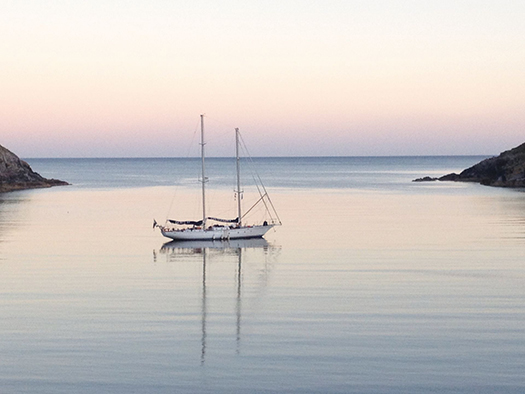
Spirit of Oysterhaven in South Harbour, Cape Clear Photo: Oliver Hart
This and much more was reflected in the Sail Training Ireland Awards Ceremony in the Mansion House, a goodly gathering which was representative not just of every possible aspect of sail training at home and abroad, but also of Irish ports which are increasingly interested in an activity which brings their ancient waterfronts vividly to life. And the progress of various ship projects was spoken for by everything from complete vessels such as the Basque Spanish schooner Atyla represented by Rodrigo de la Serna, through vessels in the making as personified by our own ketch Ilen. She has since seen her final new plank knocked ceremonially into place at Oldcourt in Baltimore, but here's an evocative video Gary MacMahon left with us of the creative planking process under way. And present too was Neil O'Hagan of Atlantic Youth Trust, whose organisation deservedly received recognition for their pioneering work towards a completely new ship.
{youtube}ZLT3D8TBbwk{/youtube}
The main awards presented in the Mansion House by STI Chairman Seamus McLoughlin, who is former Head of Operations for Dublin Port, were:
1. Trainee of the year: Andrew Crowley
2. Special Contribution Award: Turlough Kennedy
3. Special Achievement Award: Fiona Armson
4. Perpetual Asgard Award: For an outstanding contribution to, or achievement in Sail Training by an individual or group: Atlantic Youth Trust / Foroige Group of Trainees
5. Watch-leader of the Year: Sara Mason
6. Volunteer of the year: Jonathan O'Brien
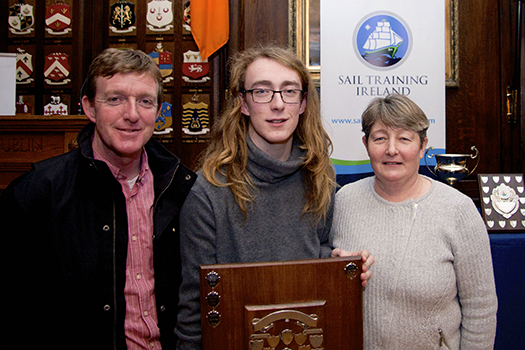
Trainee of the Year Andrew Crowley with his parents in the Mansion House
Trainee of the Year Award: Andrew Crowley
Andrew is Club Captain of the Spirit of Oysterhaven Trust. During 2014, he was instrumental in helping to organise the Club's sailing trips aboard Spirit of Oysterhaven with a special emphasis on providing opportunities for young people with disability. He helped to organise the Club's Youth in Action programme, and crewed aboard Spirit during the Irish Cruising Club's sponsored Anniversary voyage from Glandore to Glengariff with a crew of eight trainees, including several with disability. During the summer Andrew was a vital member of a short-handed crew delivering Spirit from Oysterhaven to Glandore during which he proved himself an outstanding active crew member.
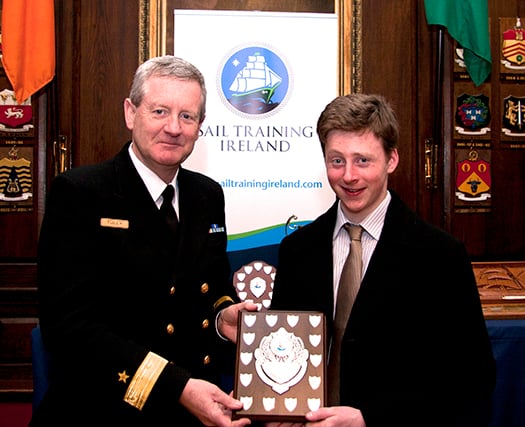
Commodore Hugh Tully, Flag Officer Commanding Naval Service, with Turlough Kennedy, who received the Special Contribution Award
Special Contribution Award: Turlough Kennedy
This year's special contribution award goes to Turlough Kennedy from the lakeside port of Scarriff in County Clare for the outstanding role he filled on the Dutch tall ship Morgenster.
To quote Michael Byrne, Director of Sail Training Ireland: "This contribution was not only recognised by us. On completion of last year's voyage Turlough - despite his limited sea going experience - was offered a crew member's berth on board the ship by the Captain. While he was not in a position last year to take up this offer for the remainder of the 2014 season, in 2015 we are delighted that Turlough will be sailing as voluntary crew on board the Morgenster. The following is a short note from the ship's Captain, Harry Muter: "Turlough sailed with us last year and he was very good good both in the sailing department as in the social processes. For his age he was surprisingly adult, patient and emphatic. And then the music, it coloured this voyage, and Turlough played a role with his complicated bagpipe and improvisation talent. Looking forward to sail with him again." " (There are no prizes for guessing that "complicated bagpipes" are Uileann Pipes).
Special Achievement Award: Fiona Armson
The special achievement award this year went to Fiona Armson for the tenacity and determination she showed by completing her 14 day voyage. Fiona found some aspects of life at sea a real challenge but despite being given several opportunities by her leaders and the crew to take on a lighter work load Fiona refused to leave her watch and pushed on.
Fiona completed her voyage having never missed a single watch or duty and, in a way that would put a smile on any sailor's face, she sailed the Gulden Leeuw into her home port of Bangor.
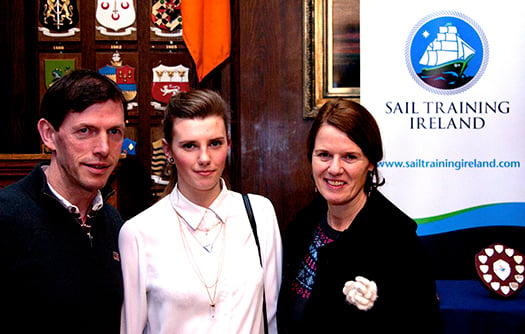
Special Achievement Award Winner Fiona Armson with her parents
Perpetual Asgard Award
Awarded to a group of four Foroige Trainees: Michael Collins, Dean Mc Keon, Brandon McDonagh, and Daniel O'Halloran,
In March 2014, four young people from Ballybane in Galway set out on a remarkable adventure, travelling half way around the world to experience the Spirit of Adventure's 10-Day Youth Development Voyage in New Zealand. Three youth workers accompanied the group for the three week trip, and one of them, Pearse O'Toole, was at the Mansion House with them. The trip was funded by a private donation and managed by the Atlantic Youth Trust and Foroige.
The group spent 10-days sailing around the magnificent Hauraki Gulf off Auckland on the barquentine Spirit of New Zealand. They adapted very well to their new surroundings as crew members and returned with fresh skills, more confidence than ever, and a new outlook on life and what is possible.
Neil O'Hagan, Executive Director of the Atlantic Youth Trust, followed this award with a presentation about the Peace and Reconciliation Fund-supported Sea-Connections scheme, and then the next award was remarkably appropriate, as it was for the Watch Leader of the Year and it went to Sara Mason for her very successful participation in an EU Youth Exchange Voyage on Gulden Leeuw.
Sara (pronounced saarah) is from the North Island of New Zealand, but now lives and studies in Dublin. She is part of the Shackleton Outdoor Adventure Management Diploma Course in Colaiste Dhulaigh in Coolock. She joined the team of youth leaders which facilitated the main voyage programme of Youth Exchange projects in May-June. As a leader on the Dutch Ship Gulden Leeuw, she cared for and facilitated a group of 40 young adults over a 14 day period. She was an outstanding support to them as a leader, and brought with her a set of skills that are unique to professionals who spend their lives working with people in the outdoor adventure industry. She also has a fantastic energy and enthusiasm and was an inspiration to the trainees and other leaders.
Volunteer of the Year Award - Jonathan O'Brien
Jonathan has become involved in a multitude of voluntary activities with Sail Training Ireland in the last year. In 2013 he volunteered as a youth leader for one of STI's youth exchange voyages for 10 days from Belfast to Dublin. In 2014 he was head-leader across youth exchange voyages with a total of 8 leaders, with at times up to 100 trainees across three ships seeking his support.
Having a background in both outdoor education and in social care, Jonathan has an exceptional set of skills that lend themselves very well to the role of leader on a tall ship, and he has now found himself "volunteered" for a position on STI's sub-committee for trainee programmes. During 2014, he also spent time on a number of ships across Europe, while somehow also fitting in a spell serving as First Mate on the Spirit of Oysterhaven. He is helping to develop on-board programmes for a number of STI's funded voyage schemes during 2015, and will also train STI's group of twelve youth leaders in April.
So the good work goes on, but the more of it there is, the more it become apparent that Ireland needs her own tall ship, and the sooner the better. A programme of international placement may work very well for those in the know, but for people down the country which are remote from maritime communities, it often takes the stimulus and sense of pride engendered by an Irish ship to make that first move afloat.
It was summed up so well by investigative academic and journalist Dr Elaine Byrne in our story about the Tall Ships on January 17th that it deserves repeating here. Usually in her line of work, Elaine Byrne takes no prisoners. But the quiet depth of feeling underlying the brief story of how the Byrne family from the deepest rural depths of County Carlow became involved in sail training has a resonance for us all today:
"I'm the oldest of seven children from a farming family on the Carlow/Wicklow border, where the household income is augmented with a funeral undertaking business attached to a pub in which I might still work on visits home. Our background is just about as far as it's possible to be from Ireland's maritime community. Yet thanks to Asgard II, I was able to take a step into the unknown world of the high seas as a trainee on board, and liked it so much that over the years I spent two months in all on board, graduating through the Watch Leader scheme and sailing in the Tall Ships programmes of races and cruises-in-company.
Down in the depths of the country, my new experiences changed the family's perceptions of seafaring. Four of my siblings then had the opportunity to sail on Asgard II. If it were not for Asgard II, my family would never have had the chance to sail, as we did not live near the sea, nor had the financial resources to do so. The Asgard II played a large role in our family life as it became a Rite of Passage to sail on board her. My two youngest siblings did not sail on Asgard II because she sank, which they much regret.
Apart from the discipline of sailing and the adventure of new experiences and countries, the Asgard II brought people of different social class and background together. There are few experiences which can achieve so much during the formative years of young adulthood".
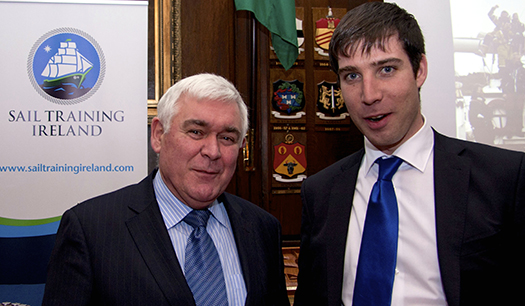
Seamus McLoughlin, Chairman of Sail Training Ireland, with Michael Byrne, Director.

Carolanna Foley, awarded a Drogheda Port Sail Training Bursary, with Seamus McLoughlin (left) and Commodore Hugh Tully
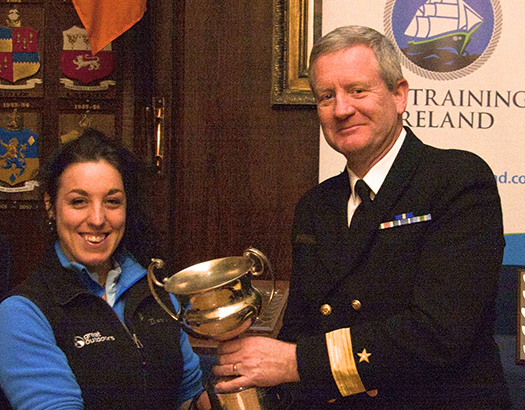
Sara Mason, Watch Leader of the Year, with Commodore Hugh Tully

Jonathan O'Brien (left) Volunteer of the Year, with Oliver Hart
- Sagres
- Tall ship
- Coiste an Asgard
- Atlantic Youth Trust
- barquentine
- Sail Training Ireland
- Sail Training International
- John Killeen
- Enda O'Coineen
- Neil O'Hagan
- Dykstra
- Damen Shipyard
- sailing
- Simon Coveney
- Lord Mayor
- Phoenix
- Spirit of Oysterhaven
- Europa
- Morgenster
- Gulden Leeuw
- Basque Spanish schooner Atyla
- Ilen
- Elaine Byrne
- Oysterhaven
- Mansion House
- Christy Burke
- World War II
New Lease of Life for Vintage Wooden Boats Is a Maritime Highlight
#woodenboats – It's an interesting time for old wooden boats. They may be traditional craft, or classics, or simply ordinary timber boats which have reached a stage in life where they need serious and special attention. Whatever the circumstances, it's clear that their situation strikes a chord with sailors everywhere. And when there's good news about a restoration, it heartens the maritime community to know that worthwhile plans are being implemented. W M Nixon takes us on a tour.
The maritime highlight of this past week was down in the far southwest, at the ceremony in Liam Hegarty's boatyard at Oldcourt above Baltimore on the River Ilen when the "whiskey plank" was fastened in place to complete the hull re-build of the 1926 Conor O'Brien 56ft trading ketch Ilen. It has been a long haul since Ilen was brought back to Ireland from her working area in the Falkland Islands in 1997. Yet somehow, despite all sorts of problems of which the economic recession was only one, the Ilen really is starting to look ship-shape again.
Then in another part of the country, the word had come through that one of the Belfast Lough 27ft S Class sloops, twenty of which were built on the shores of Ballyholme Bay between 1946 and 1963, was facing extinction in a corner of County Louth. The news resulted in a flurry of photos on the Afloat.ie website spurred on by the indefatigable Pat Murphy, and soon the Sorona found herself a new home in a yard in Newry.
There, the story is that she'll be sharing space with the vintage ketch Silvery Light, a substantial vessel built in 1884 on the beach at St Ives in Cornwall to be a herring drifter, and now undergoing a much-needed restoration in Newry after being brought by new owners into Carlingford Lough last Autumn.
Sorona may have been only 52 years old. But her deteriorating condition was a reminder that the climate of Ireland and the seas around us can be merciless to a wooden vessel unless - whether deliberately or by happy accident - the boat is stored in a timber-friendly sheltered environment which is not too hot or cold, nor excessively wet or dry.
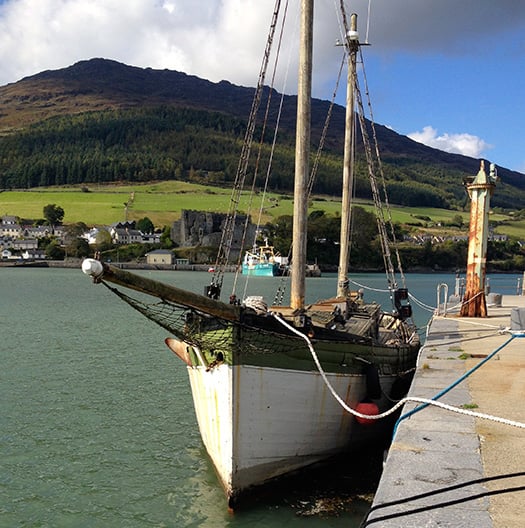 A formidable restoration challenge. The 1884-built ketch Silvery Light – seen here in Carlingford last October – will be undergoing restoration in Newry. Photo: Peter Redmond
A formidable restoration challenge. The 1884-built ketch Silvery Light – seen here in Carlingford last October – will be undergoing restoration in Newry. Photo: Peter Redmond
In the middle of the Irish Sea in the ancient capital of the Isle of Man at Castletown, the 26ft schooner Peggy had survived remarkably well in her harbourside "boat cellar" under Bridge House. In fact, her survival was miraculous, as Peggy was built in 1789, making her probably the oldest yacht in the world. But in recent years, it became clear that a major conservation project was going to be needed to preserve this unique craft.
And just three weeks ago, for the first time in 180 years, the Peggy was removed from her private space in a skilled operation. She is now safely ensconced in a specially prepared conservation workshop in the island's modern capital of Douglas, where it is anticipated the painstaking process of preserving this exceptional gem of maritime heritage could take five years.
Once you have the ideal conditions of micro-climate in place for doing the job, conservation is a long haul, a project of infinite patience. One of the best examples of how it can be done successfully is in Dublin with the Asgard, now on display in Collins Barracks. John Kearon, who learned his shipwright skills in Arklow and then broadened them to include historical work with the Liverpool Maritime Museum, was to lead the team working on this from 2007 until its completion in 2012.
The result is a multi-value display, as the 1905-built Asgard has her place in Irish history through the 1914 gun-running to Howth, she is also totally associated with Erskine Childers which takes us, among other elements in a complex history, into the world of his 1903 best-selling espionage novel The Riddle of the Sands, and she is a marvellous example of the work of the great designer-builder Colin Archer of Norway in creating a very able seagoing yacht of the era, one of the best cruising vessels of her time.
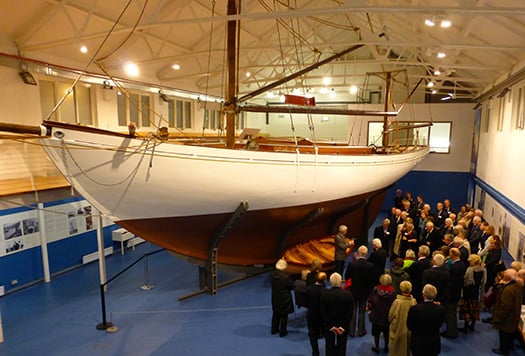
The Asgard in Collins Barracks is a fine example of conservation. A group of Erskine Childers enthusiasts from the Royal Cruising Club is seen here listening intently to a talk by conservator John Kearon about the vessel and the preservation work done with her by his team. Throughout her ownership by Erskine & Molly Childers from 1905, Asgard played a prominent role in the activities of the RCC, and in 1913 their friend Gordon Shepherd was awarded the club's historic Challenge Cup for his remarkable Autumn cruise with Asgard from Norway to North Wales via the Shetland Islands and the Hebrides. Photo: W M Nixon
In her day, the little Peggy was also something of a unique star. Though based in the Isle of Man and most active during the 1890s, she was never in Ireland. Had she been seen on the Irish coast, it would probably have been because she'd been captured by the privateers and smugglers of Rush in North Dublin, who were the capture and contraband industry leaders of their day.
So when Peggy's owner George Quayle (1751-1835) took her "abroad", it was prudently to northern England to race successfully against a small fleet of early yachts on Windermere in the Lake District, though we can be sure that if the men of Rush had come anywhere near him, Quayle would have put up a gallant fight, as Peggy was an armed yacht with miniature cannons which most certainly weren't toys.
But it's the realization that Quayle was active at sea with the Peggy in the years after Luke Ryan of Rush was at his busiest, yet before James Mathews of the same port was at his most active, which helps us to grasp her historical significance. She was sailing the Irish Sea well before the Battle of Trafalgar. But thanks to being immured for a hundred years in her boat cellar after George Quayle died in 1835, this small but significant vessel has survived to become something of extraordinary value today.
Her inevitable deterioration was accelerating in recent years because of mineralization of her fastenings, which were not only consuming themselves, but were damaging all the timber about them. However, her conservation was not something to be undertaken lightly. The provision of a proper facility had to be organised, and then the liftout, clear over the tops of the harbourside houses, had to be planned within inches.
It was all relatively new territory for many of those involved, with much preparatory work. So what had originally been planned as an Autumn 2014 lift finally became possible in late January 2015, just when the weather went to pot, with one gale after another making for impossible conditions. But then one cold Thursday morning at the end of January, the wind maps suggested the arrival of a brief lull in the northwest gales. It arrived exactly on time on a sunny day suggestive of early Spring, and gently but steadily the Peggy emerged.
As Chris Weeks of Manx Heritage remarked as he watched from the parapet above George Quayle's little boat dock, the one thing
they didn't want to hear was any creaking or groaning. If the special lifting cradle was doing its job, the Peggy would rise from her nest of 180 years in perfect silence. And that's exactly how it went, with the lift done in two stages as they were working in very confined streets and spaces.
{youtube}-UyKjwdAhgw{/youtube}
Of course, after all the fuss those of us in the Peggy Appreciation Society have been making for years, when she did finally come into the open the inevitable reaction was: "But she's very small". What on earth did they expect? Something like Nelson's Victory rising up over the old houses of Castletown? How many times do we have to reiterate that she's only 26ft in overall length, just a foot longer overall than a Folkboat, though with greater bulk and a longer waterline.
What her emergence did properly reveal, for the first time in all those 180 years, is just how much the Peggy is a vessel of her era. This is indeed a ship – albeit a miniature one – of the 18th Century. But she's an 18th Century high performance mini-ship nevertheless – this is undoubtedly a vessel well worth conserving.
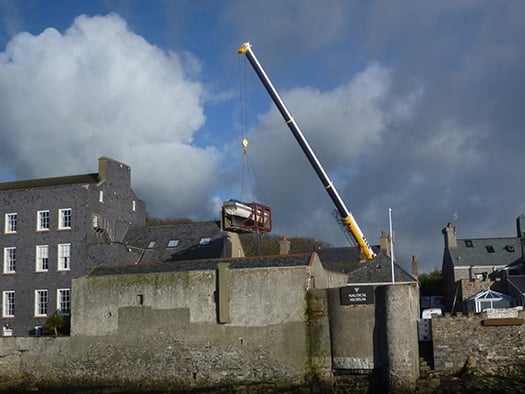
Peggy aloft. The newest crane in the Isle of Man lifts the oldest boat in the Isle of Man. Photo: Michael Kneale
So the day went well. And for those with a technical interest in such things, the word is that the delicate lifting of the oldest boat in the Isle of Man was done by the newest crane on the Isle of Man, a Japanese made Tadano recently delivered (for a cool £550,000) to Mann Crane Hire whose boss Chris Barnes was understandably proud of the smooth work put in by his supervisor Colin Fitzgerald and crane driver David Hooper.
Thanks to their good work everyone was able, for the first time in 180 years, to fully admire and savour the Peggy's lines. To the uninitiated, she may look like just another 26ft clinker-built boat. But for connoisseurs, she's living history with a stylish hull, as she has the most gorgeous hollow waterlines forward, and a sweet run aft – George Quayle had himself a flyer.
 To a casual observer, this may look like just another 26ft clinker-built boat. But for connoisseurs, this is a genuine miniature of a 17th Century ship - the Peggy is very special. Photo: Michael Kneale
To a casual observer, this may look like just another 26ft clinker-built boat. But for connoisseurs, this is a genuine miniature of a 17th Century ship - the Peggy is very special. Photo: Michael Kneale
So it's a bit sad that, as with the Asgard, we have to accept that conservation means the Peggy will never sail again. But thanks to John Kearon's painstaking work, the plans of Asgard as she was originally in 1905 are readily available for any group wishing to build a seagoing replica. Stranger things have happened. And as the Peggy is of such a manageable size, it's even more likely that a new seagoing replica of the little Manx schooner will appear some time, and maybe sooner rather than later. After all, she'd be much the same size as the "new" Shannon hooker Sally O'Keeffe down in Kilrush, which is absolutely on target as a community maritime project.
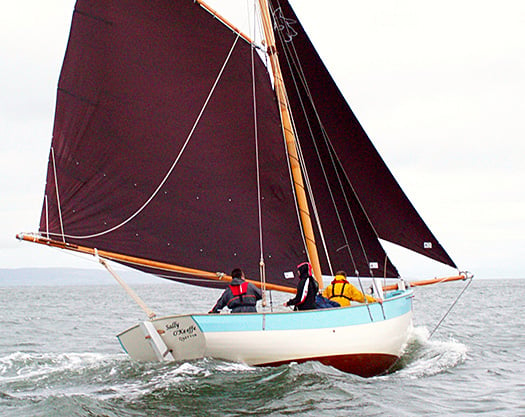
The 2012-built Sally O'Keeffe on the Shannon Estuary is much the same size as the Peggy of Castletown.
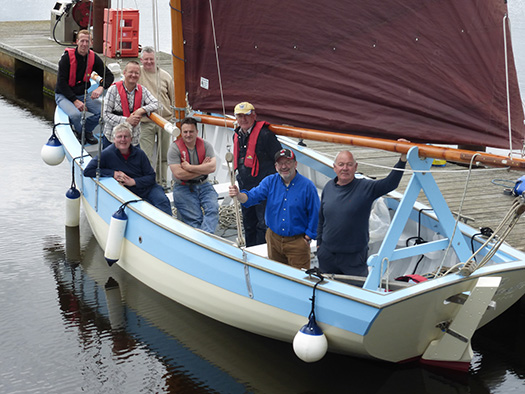 A genuine community project. Some of the team who built Sally O'Keeffe in Querrin aboard the boat in Kilrush with lead builder Steve Morris second left in the trio up forward. Photo: W M Nixon
A genuine community project. Some of the team who built Sally O'Keeffe in Querrin aboard the boat in Kilrush with lead builder Steve Morris second left in the trio up forward. Photo: W M Nixon
Nevertheless after immersing ourselves in the dusty academic topic of proper boat conservation, it's like a breath of fresh air to consider the Ilen, for she will definitely sail again. Tom MacSweeney of this parish was at the ceremony, so we'll defer to himself for his detailed report on the occasion in the fullness of time. But just from looking at the photos, you can get some idea of the quality of the workmanship that Gary MacMahon and his team from the Ilen Trust and Boatbuilding School in Limerick are getting from Liam Hegarty and his shipwrights at Oldcourt.
The pure style of the new planking is a joy to behold. And as for the use of classic bronze spikes for the fastenings, they're a work of the craftsman's art in themselves. Gary MacMahon brought one along to the recent Sail Training Ireland Annual Awards ceremony in the Mansion House in Dublin, and in that setting and on that occasion, you couldn't help but think that if our impoverished nation had been able to utilise bronze fastenings of this standard in Asgard II when building her in the late 1970s, rather than the galvanized steel fastenings that had to be used, then our beloved sail training brigantine might still be sailing today.
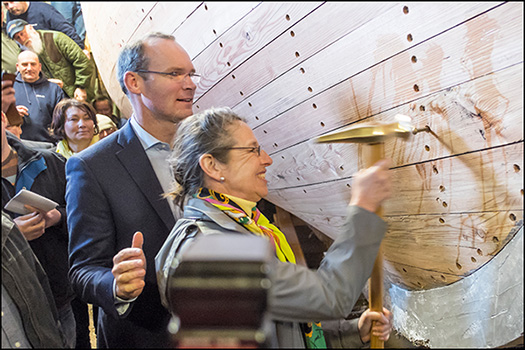
Quality work at every level. The superb workmanship on the Ilen restoration by Liam Hegarty is much in evidence as Minister for the Marine Simon Coveney supports Kate Jarvey of the Ruth Lilly Philanthropic Trust as she drives the bronze fastening to complete the "whiskey plank". Photo: Kevin O'Farrell
But Asgard II is long gone, and so too is Conor O'Brien's Saoirse, the 42ft Baltimore-built ketch in which the Limerick sailor made his extraordinary voyage round the word south of the Great Capes in 1922-25. Thus Ilen is the only tangible link to that remarkable and very historic achievement. For those who enjoy looking at line drawings of boats (not everyone does - there are some who claim that such technical stuff makes them feel "disenfranchised"), it's intriguing to compare the lines of the 42ft Saoirse and the 56ft Ilen.
They're clearly sisters, but you'll note that the Ilen people have made sure that Tom Moynihan of Baltimore is given a significant amount of credit for the design, for down in West Cork they'll tell you that for all that Conor O'Brien was an architect by profession, it took Tom Moynihan's skills to turn his rough concept sketches into vessels capable of sailing so ably across the oceans.

The lines of Ilen as taken off the hull by laser scanner
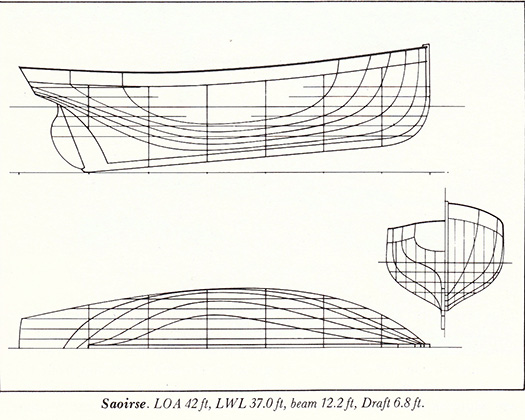
The hull lines of Saoirse as interpreted by Myles Stapleton (designer of Sally O'Keeffe) from basic drawings by Conor O'Brien
An Irish designer who didn't need anyone's help to make his creations look like proper boats was John B Kearney (1879-1967). He may have started his working life as a boy apprentice at Murphy's Boatyard in Ringsend in the early 1890s, while his working life was to be spent with Dublin Port & Docks where he rose to be Superintendent of Engineering Works. But his lifetime ambition was always to be a yacht designer, he trained and studied for it in his very limited spare time from boyhood, and then he worked at it throughout his long retirement. When he finally died at the age of 87, his gravestone in Glasnevin says it all, as it simply reads: John Breslin Kearney.....Yacht Designer. Beloved and respected by all that knew him.
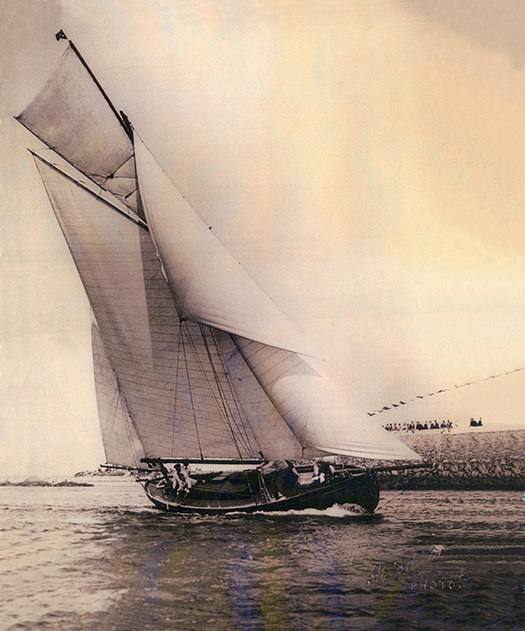
Mavis in her element under Skipper Kearney's command, on her way to winning Skerries Regatta in 1928
For everyone who sailed with him in his many successful cruises and races, he was always Skipper Kearney, and Skipper Kearney's finest creation was the 38ft yawl Mavis which he designed and built himself in Ringsend in 1923-25. Mavis went to America in 1956, and from time to time we've mentioned the continuing process of restoration on her in Camden, Maine, which has been going on for quite a few years now. It has been a lengthy process as owner/restorer Ron Hawkins has to take time out now and again to earn extra funds as a shipwright in order to to keep the Mavis restoration show on the road.
But it's getting there at last. So much so, indeed, that having given the hull of Mavis its first coat of paint in more than twenty years just a couple of weeks ago, Ron and his partner Denise Pukas are now talking of a re-launch date of July 4th 2015 for the restored ship, this treasure of the Irish yacht designer's art and craft.

The quality of workmanship in the restoration of Mavis is clearly displayed. Note how John B Kearney skillfully carried the beam well aft in order to provide a wide and comfortable afterdeck despite incorporating a canoe stern. Photo: Denise Pukas
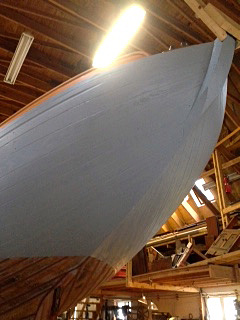
The canoe stern on Mavis with its first coat of fresh paint in 20 years. Here we can appreciate again how John Kearney managed to have an elegant canoe stern while providing plenty of deck space aft. Photo: Denise Pukas
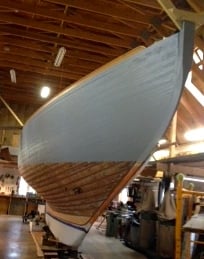
The most famous Kearney hull of all begins to emerge from restoration. It is hoped to re-launch Mavis on July 4th 2015. Photo: Denise Pukas
It would be pleasant to keep this week's commentary on a good news theme right through to the end, but the various emails about saving the Sorona from an untimely end in County Louth brought the information that there are skilled boatbuilders in places like Arklow who are looking for boats needing restoration - not as a commercial venture, but rather as a worthwhile private project.
The secret of it all is surely being able to assess if a particular boat is too far gone to be within your restoration capabilities and resources. Be that as it may, it was sadly ironic to reflect that within yards of the bright and cheerful festival which celebrated the final plank being installed on the Ilen, there's a derelict little boat which would be very rewarding to restore, but it's likely that she's so far gone it's actually a re-build you'd be contemplating.
We're talking of the Englyn, the Harrison Butler-designed 26-footer which came up on the radar last May when were discussing the new 31ft Harrison Butler-designed Khamseen class which Steve Morris, lead builder of the Sally O'Keeffe, is constructing beside his house near Kilrush. But while Steve's boat is starting to look very healthy indeed, sad little Englyn is anything but as she lies abandoned within yards of the Old Cornstore where Ilen is being so beautifully re-born.
Part of the problem in getting anyone interested in the Englyn – which was built in 1934 in Southampton – is that her only link to Ireland was through various owners later in her life. Yet in her day she was considered a classic, so much so that when Eric Hiscock's defining book Cruising Under Sail was published in 1950, Englyn was one of the featured designs. And as the designer Harrison Butler was professionally an ophthalmic surgeon who put heart and soul into everything he did, when Hiscock asked him for the plans he went to infinite pains to bring them to life as a vision of a proper little cruising yacht, even to having a trussed chicken shown in the meat locker.
Over and above that, when looking at Englyn's plans it's not unreasonable to think that, 25 years before Lyle Hess was starting to design his first characterful boats, Harrison Butler was thinking along much the same lines. And he had the boats afloat to prove it.
But that piece of thinking is another day's work. For now, give us a moment of your time to consider the drawings of Englyn as she was in her prime. Then pause briefly to consider sadly how she looked last Monday as Ilen was re-born nearby. And then let's hear it from those who say they're looking for a worthwhile restoration project.

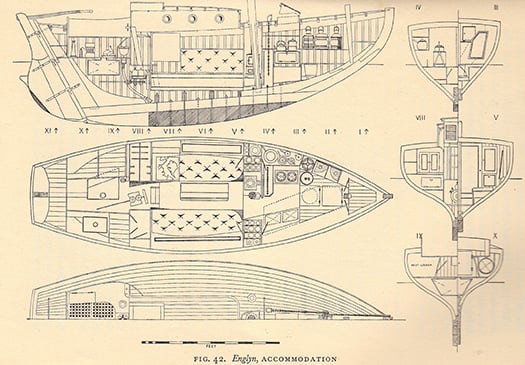
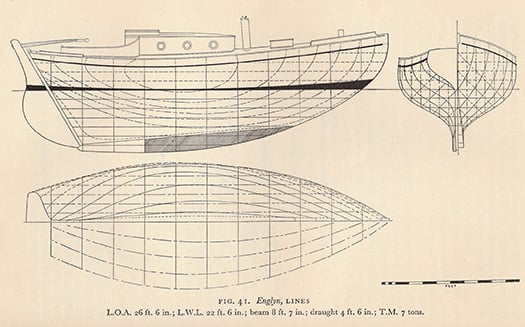
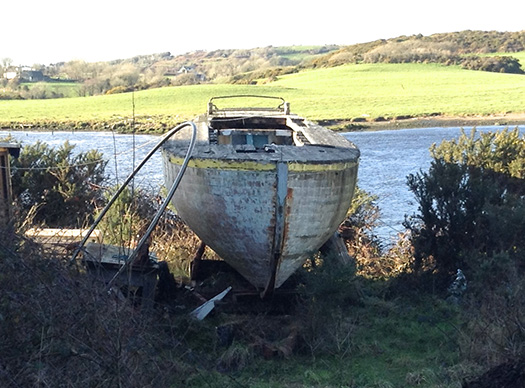
Englyn as she was last Monday at Oldcourt, as the re-birth of Ilen was being celebrated nearby. Photo: John Wolfe
Ilen – Uniting Ireland's Coastal Communities Through Educational Endeavour
#ilen – As previously reported by Afloat.ie, the good ship Ilen's whiskey plank was jointly nailed home by Minister For The Marine, Simon Coveney, Mrs Kate Jarvey of Ruth Lily Philanthropic Trust, Mr Gerry Boland of JP McManus Charitable Foundation, Rear Admiral Mark Mellett, the Deputy Chief of Staff of the Defence Forces and Gary MacMahon, director of Ilen School.
Minister Simon Coveney praised the educational model of the Ilen School and the quality of it's community work. He also delighted in the high quality of shipbuilding in the ongoing reconstruction of the good ship Ilen.
As a sailor of wooden boats he related his deep appreciation and enthusiasm for the great traditions of vernacular boatbuilding, and further added that there should be many ships in the style of the Ilen plying a new contemporary trade in community education and national tourism on the south and west coast of Ireland. He also remarked on the unique capacity of boats to unit coastal community – in this particular case the communities of Limerick City and Baltimore, West Cork.
– Over 150 guests attended the ceremony in the Cornstore of Hegarty's Boatyard, leaving little room to swing the custom cast bronze maul.
– Brother Anthony Keane of Glenstal Abbey, director of Ilen School, was MC for the occasion and gave a wonderful and numenious address, evoking the great sea myths of Ireland, and, in the immemorial custom of boatbuilding, doused the wooden hull with Irish whiskey, generously sponsored by Teeling Whiskey.
Michael Byrne of Sail Training Ireland also attended the ceremony – his organisation plan to extend their national sail training programme to include youth in Limerick this year in a joint venture with the Ilen School, and go on to place trainees on the Ilen, when with a fair wind she might enter her operational phase in 2017.
The event was also attended by participants and instructors from the Ilen School, the shipwrights of Hegarty's Boatyard, Oldcourt as well as many officanados from the maritime sphere.
The event was also attended by Tom MacSweeney, who interviewed and recorded the principal project personalities for his maritime radio programme This Island Nation.


